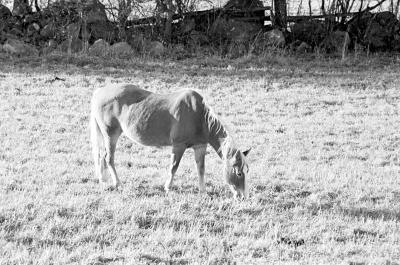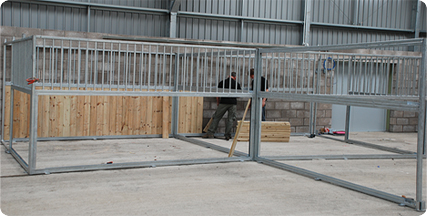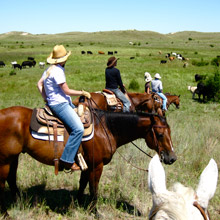Learning to ride a horse isn't easy. There are so many things that you need to remember and they aren't always related to the horse. Always ensure that you have the correct clothing and a helmet that fits properly before you start. Then you are ready to continue with the rest.
How to correctly mount a horse
When the bridle and saddle have been correctly fitted and double-checked, stand to the left of the horse. Place your left foot in the stirrup, and grasp the withers (mane), not the saddle as this will cause it to slide. Then keeping both of your hands on the front of the horse or on the cantle (back) of the saddle, push up and swing your right leg over the back of the horse, being careful not to kick the horse, so that you seat yourself comfortably in the saddle. When comfortable, reassess your grip on the reigns and hang both your legs down near the stirrups. Make sure they are at the correct length by having the stirrup reach your ankle. Then you should be able to just slide your feet into the stirrup whilst your foot is raised a few inches. Remember that it important that you are balanced to the horse, not them to you.
Now you are sitting comfortably...
Keep your upper back straight and lower back relaxed. Sit tall in the saddle. Always look ahead so that you can see for anything that might spook your horse. Take one rein in each hand; left rein in the left hand, right rein in the right hand. Tuck the reins under all four fingers, with the reins going in under the little fingers. Always hold the reins in place with your thumbs against your forefingers with your thumbs up, palms down and each hand as wide apart as the neck of the horse with them just in front of the saddle and above of the horse. To let more rein in, slide it through by lifting your thumbs. Shorten them by using the opposite hand to take up extra length.
Starting to ride your horse
To start the horse off with a slow walk - the first gait - squeeze your lower legs. After a few minutes stop and check the girth. If you can feel more than one hand under and between the girth and the horse, then you must tighten it. Carry on walking, keeping your heels down, back straight and chin up. You should be able to draw a straight line from the heel to the shoulders. Pull slightly on the reigns so as to turn the horses head enabling you to turn. When you need to stop, simply pull back on the reins and sit deep into the saddle; sometimes you may need to lean back, then relax the reigns and praise your horse. Always release the reins when you stop as this will praise and reward your horse; also they might pull if you don't. Horses can jerk short reins out of your hands, so try to make them long. Practice these basic moves until you and the horse are comfortable with it all.
When you are both ready, try trotting - the second gait. Again, squeeze the horse with your legs and the horse will start to move faster. With a trot, you need to learn how to rise and sit with the trot of the horse. You will need to rise and sit with the movement of the horse without bumping. This takes a bit of getting used to, and you will be using muscles which you may not be used to using! Thinking "lift, sit, lift, sit" in time to the rhythm will help you with this. Try not to sit too heavily as you may unsteady the horse. When you wish to slow down, sit deep in the saddle and pull back slightly on the reins. Again practice this until you are comfortable with the movements. When you are happy, trying turning and stopping from a trot.
Cantering is the next step - the third gait. This is often only managed after weeks of trotting. To ask for canter, squeeze your outside leg while having it back a bit and then squeeze with your inside leg. It's sometimes best to sit trot and then ask, so you are sitting ready for the canter. This means that you should sitting back slightly; when you feel you're sitting back, you're about right. Whilst in a canter, you should be rocking forward backward, with your bottom slightly off the saddle. Again, keep on practicing this as this will take longer to grasp. Ensure you are wary of your posture and heels as you practice; back on your heels and rocked forward but straight with your body.
After mastering the canter, you can move on to a gallop - this is the fastest gait. Again squeeze your calves as you have before, but you must be in a canter. As with the canter you should be sitting slightly forward in the saddle, with bottom off the saddle. It is always advisable to ensure that you are fully confident and well-practiced with each gait before you move on to the faster gait.
When dismounting your horse, swing your right leg over to the back of the horse. Stay balanced with a good grip on the saddle so you don't slip. Then lower yourself down from the left side, you should try to put both your legs down at the same time, keeping your knees slightly bent to absorb the weight.
Other helpful horse hints
Get to know your horse. Always ensure that you approach him carefully from the front or side; touching him and talking to him, thus avoiding spooking him and being hurt by a kick. Then move towards his shoulder, so he knows you're coming closer.
If you are new to a horse, or riding, always make sure that you have had proper rider training before you attempt anything on your own. Try to avoid riding alone; never ride alone if you are a beginner.
Even though it will be a shock and could very possibly hurt when you fall off, try to get straight back on.
Never kneel or sit by a horse; if you are tending to them, always make sure that you are positioned so that you can jump aside quickly if need be.
Make sure that you are comfortable on the horse that you are riding; they will be nervous too if they sense that you are uneasy.
Never yank the bit, as this will hurt the horse and distress him. If you handle it carefully, he will be more relaxed and easier to ride.

 How to Get Rid of Rain Rot on My Horse
How to Get Rid of Rain Rot on My Horse
How to Get Rid of Rain Rot on My Horse
How to Get Rid of Rain Rot on My Horse
 How to Fatten Up a Skinny Horse
How to Fatten Up a Skinny Horse
How to
How to Fatten Up a Skinny Horse
How to Fatten Up a Skinny Horse
How to
 How to Hook Up a Horse Harness to a Cart
How to Hook Up a Horse Harness to a Cart
How to Hook Up a Horse Harness to a Cart
How to Hook Up a Horse Harness to a Cart
 How Customized Steel Stables Are Beneficial?
Choosing the place for the horses and constructing it for th
How Customized Steel Stables Are Beneficial?
Choosing the place for the horses and constructing it for th
 Reasons to Consider Horse Ranch Vacation For Your Next Adventure Trip
Experiencing a horse pack trip and enjoying the beauty of na
Reasons to Consider Horse Ranch Vacation For Your Next Adventure Trip
Experiencing a horse pack trip and enjoying the beauty of na